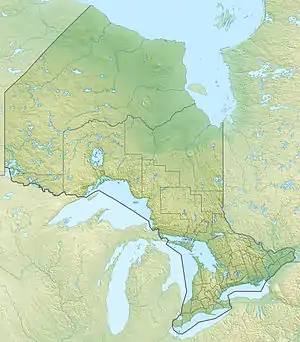| Lake St. Joseph | |
|---|---|
 Lake St. Joseph Location in Ontario | |
| Location | Kenora District and Thunder Bay District, Ontario |
| Coordinates | 51°03′13″N 90°49′38″W / 51.05361°N 90.82722°W[1] |
| Type | Lake |
| Part of | James Bay drainage basin |
| Primary inflows | Cat River, Doghole River, Miniss River, Pembina River |
| Primary outflows | Albany River, diversion to the Root River |
| Basin countries | Canada |
| Max. length | 90 kilometres (56 mi) |
| Max. width | 18 kilometres (11 mi) |
| Surface area | 493 square kilometres (190 sq mi) |
| Surface elevation | 374 metres (1,227 ft)[2] |
Lake St. Joseph is a large lake in Kenora District and Thunder Bay District in Northwestern Ontario, Canada.[1] It is in the James Bay drainage basin and is the source of the Albany River. The east end of the lake can be reached using Ontario Highway 599 from the town of Ignace, 260 kilometres (160 mi) to the south on Ontario Highway 17. The nearest town is Pickle Lake, 30 kilometres (19 mi) north along Highway 599.
History
In fur trade days, the lake was part of a canoe route west from James Bay using the Albany River, Lake St. Joseph, the Root Portage,[3] Lac Seul, the English River, the Winnipeg River, and Lake Winnipeg. The Hudson's Bay Company established Osnaburgh House on the lake in 1786, and it operated there until 1939.[4]
Fishing
This lake is a large freshwater fishery with a wilderness designation. Persons wishing to fish this lake must receive a special permit from the Ontario Ministry of Natural Resources. This permit is in addition to any licenses needed. Access is restricted because of the wilderness designation. Most persons wishing to fish this lake will have to stay at one of the fishing camps operating on the eastern end of the lake. There is an outpost camp located on one of the islands in the centre of the lake. Main species are walleye, northern pike and yellow perch.
Diversion
An agreement was reached between the provinces of Manitoba and Ontario to undertake a diversion of Lake St. Joseph and enacted into law in 1958. The diversion was undertaken to expand a hydroelectric generating station at the outflow from Lac Seul into the English River at Ear Falls, to augment a station at Manitou Falls further downstream on the English River, and to augment generating stations further downstream on its parent river systems — the Winnipeg River and Nelson River — on the way to Hudson Bay.[5] Dams at Rat Rapids at the Albany River outflow at the northeast of the lake partially back up the outflow and divert water over a control dam (50°52′10″N 91°27′12″W / 50.869506°N 91.453242°W) at the south end of Root Bay at the southwest end of the lake, into the Root River in the adjacent Lac Seul drainage basin. The diversion channel is adjacent to the historic Root Portage.[3]
Tributaries
Clockwise from the Albany River outflow at Rat Rapids
- Doran River
- Miniss River
- Cat River
- Pembina River
- Matapesatakun Creek
- Doghole River
See also
References
- 1 2 "Lake St. Joseph". Geographical Names Data Base. Natural Resources Canada. Retrieved 2014-12-19.
- ↑ Taken from Google Earth at geographic coordinates, accessed 2014-12-19.
- 1 2 "Root Portage". Geographical Names Data Base. Natural Resources Canada. Retrieved 2014-12-19.
- ↑ "Post maps - Osnaburgh House (Ontario)". Hudson's Bay Company Archives. Archives of Manitoba. Retrieved 2014-12-19.
- ↑ "R.S.M. 1990, c. 245 - The Manitoba-Ontario Lake St. Joseph Diversion Agreement Authorization Act". Government of Manitoba. Retrieved 2014-12-19.
Other map sources:
- Map 16 (PDF) (Map). 1 : 1,600,000. Official road map of Ontario. Ministry of Transportation of Ontario. 2014. Retrieved 2014-12-19.
- Restructured municipalities - Ontario map #2 (Map). Restructuring Maps of Ontario. Ontario Ministry of Municipal Affairs and Housing. 2006. Archived from the original on 2014-04-10. Retrieved 2014-12-19.